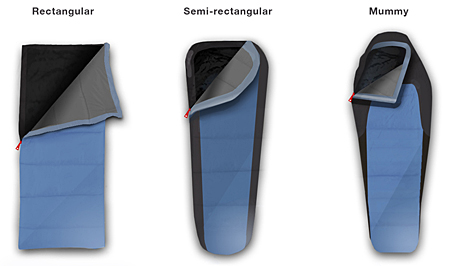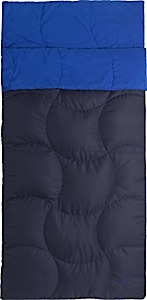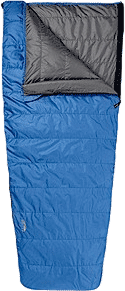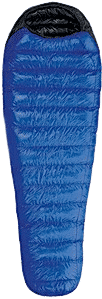Choosing a sleeping bag requires understanding the different shapes, sizes, and versions available.
- Shapes: mummy, rectangular, semi-rectangular
- Sizes and fits: length, double wide, women's, children's
- Specialty bags: half bags, over bags, parka bags, quilts, top bags
- Liners and covers: liners, vapor barriers, covers
Shapes

Sleeping bags come in rectangular, semi-rectangular, and mummy shapes. (Illustration by Sarah Lampe)
Rectangular: Not recommended for backpacking, these bags provide greater room to move around and could potentially be more comfortable space wise. They are less efficient at keeping you warm than a mummy bag, due to the extra space. Rectangular bags are better for car camping where it doesn't matter if you bring a heavier, larger bag.
Semi-Rectangular: These are hybrids bags that pair the narrow foot box of a mummy with the large opening and added comfort of a rectangular bag.
Mummy: Wilderness backpackers usually prefer a mummy-shaped bag. These have a closer, tapered fit and a hood to seal the head. Less space means less weight and better insulation because there is a smaller area to heat up.
However, mummy bags can be restrictive for some. View the hip and shoulder girth specs of a bag. The narrower the area, the lighter the bag and the better thermal efficiency. Consider comfort and how much room you need to move around, but remember, too much extra space will make the bag inefficient.
Sizes and Fits
Short to Long Length: Bags often are available in short, regular, and long lengths. Some backpackers prefer a little extra length. In winter, the extra space scan be used to store gear that needs to be kept warm, like boots or boot liners. Shorter campers will stay warmer in a bag closer to their actual height. If you're in between two lengths, consider the longer bag.
Two-Person Bags: Several companies make double wide sleeping bags for two to share. They usually are rectangular. If you have a left-zip bag and a right-zip bag with compatible zippers, you can mate two bags together to create your own two-person bag.
Women's: Women may find that a gender-specific bag better mirrors their body shape. These bags may feature a shorter length, narrower shoulders, wider hip area, and extra insulation around the torso and/or feet.
Children's: Kids sleep colder at night than adults, and also need a smaller bag to match their smaller size. Children's bags may include anti-snag zippers and leave out elastic or cords in the hood area for safety.
Specialty Bags
Elephant's Foot/Half Bags: An elephant's (or elephant) foot bag is a minimalist half or three-quarter length sleeping bag. The waist high bag is used in conjunction with an insulated, hooded parka and may have suspenders. Elephant foot or half bags are primarily used by alpinists for light and fast travel or emergency bivys.
Over Bags: An over bag is a larger bag you add to the outside of a current sleeping bag for greater warmth. Typically a three-season bag is used inside with a warm weather bag outside. The two bags can be used together as a winter sleeping system or separately for three-season use. Layering two bags can cost less and offer more year-round versatility.
Parka Bags: A few companies manufacture sleeping bags that can be worn as parkas around camp. Simple parka bags feature side zips for the arms and feet, permitting limited mobility. Advanced parka bags feature insulated sleeves and legs, and resemble an insulated suit.
Quilts: Insulated quilts, or blankets, provide insulation only on top (in a regular sleeping bag, the bottom insulation is compressed, making it less efficient). More common among ultalighters, quilts are lighter and more packable than a full bag and are usually shaped to prevent drafts. Some have Velcro tabs or elastic straps to affix them to a sleeping pad. Some are available in two-person versions.
Top Bags: Similar to a quilt, top bags are sleeping bags with no insulation on the bottom, though they do have an empty sleeve on the bottom, designed to slide onto a sleeping pad. With no insulation on the bottom, they are designed for use with a sleeping pad.
Liners and Covers
Liners: Sleeping bag liners add warmth and help keep the inside of your bag clean, minimizing wear. Dirt and body oils impair the warmth of the sleeping bag, and it's easier to wash a liner than a whole bag. Thicker synthetic or fleece liners can add up to 15 degrees of warmth to the temperature rating of a bag.
Vapor Barrier Liners (VBL's): Vapor barrier liners are thin, impermeable liners that minimize heat loss caused by evaporating sweat. VBL's prevent bags from losing loft and gaining weight due to sweat freezing in the bag's fill, especially over longer multi-day trips. Since VBL's are non-breathable, they are for use in below freezing temperatures, otherwise they can create a humid, sweaty environment.
Covers: Are waterproof (sometimes waterproof-breathable) shells that are placed over sleeping bags to improve moisture resistance and warmth. Lighter than a bivy sack, they often don't include a hood, bug netting, or other features found in bivy sacks. Tarp campers sometimes make use of sleeping bag covers to keep their sleeping bags dry from outside moisture (however, a waterproof cover will trap interior moisture from the user inside the bag.)
(With reporting by Seth Levy)

 by Heather Sable
by Heather Sable












